Title of the work
Country of the First Edition
Country/countries of popularity
Original Language
First Edition Date
First Edition Details
Jan Parandowski, Wojna trojańska. Według Iljady Homera opowiedział dla młodzieży Jan Parandowski. Lwów: Państwowe Wydawnictwo Książek Szkolnych, [s.a., c. 1927], 78 pp.
ISBN
Genre
Adaptation of classical texts*
Target Audience
Crossover (Children, teenagers, young adults)
Cover
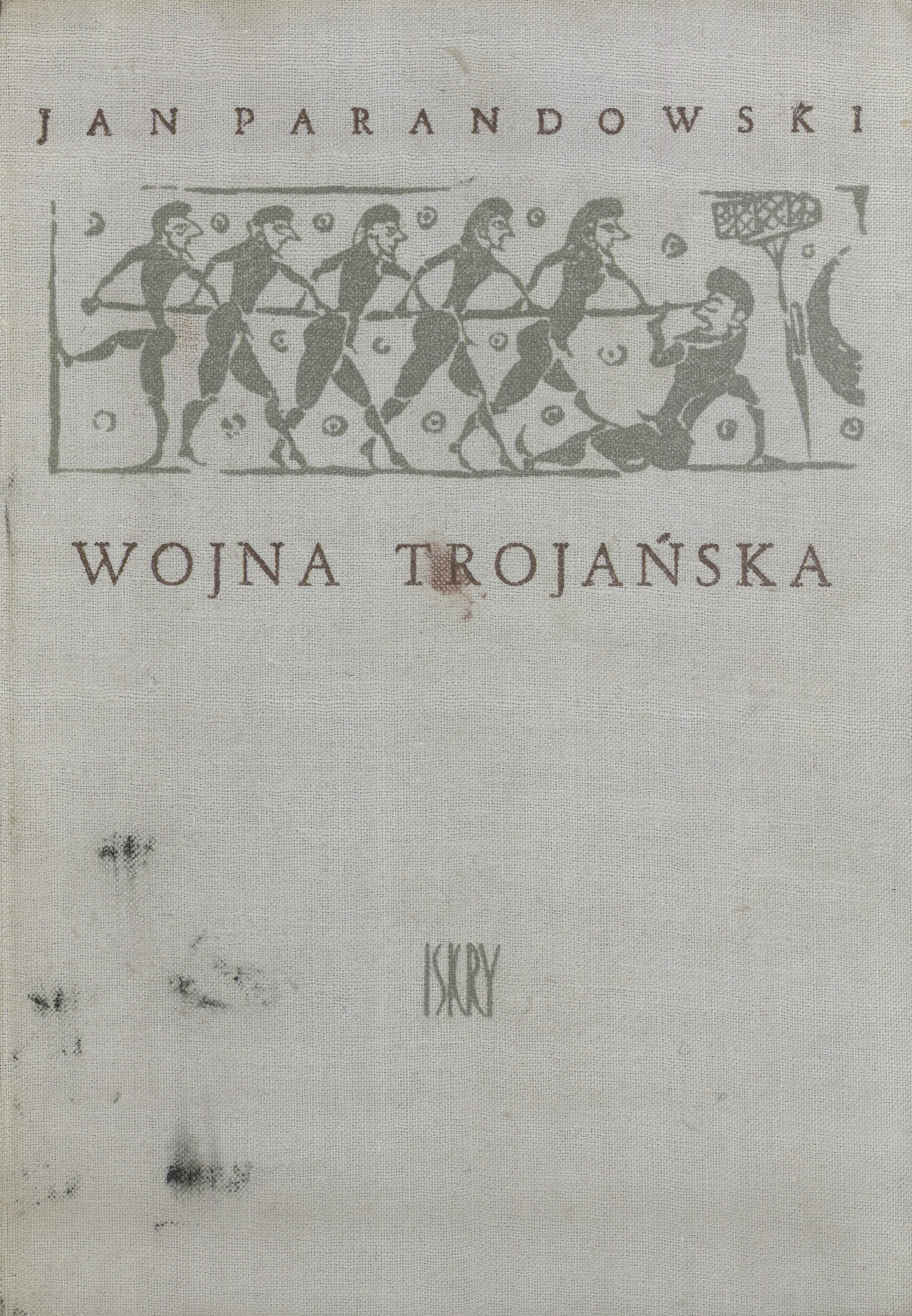
Cover from the edition Warsaw: Iskry, 1958. Illustrations by Zbigniew Parandowski.
Author of the Entry:
Summary: Joanna Kozioł, University of Warsaw, joasia7777@interia.pl
Analysis: Marta Pszczolińska, University of Warsaw, m.pszczolinska@al.uw.edu.pl
Peer-reviewer of the Entry:
Katarzyna Marciniak, University of Warsaw, kamar@al.uw.edu.pl
Elżbieta Olechowska, University of Warsaw, elzbieta.olechowska@gmail.com
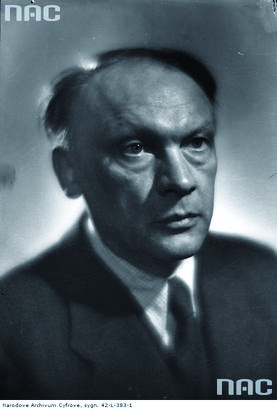
Photograph by Edward Hartwig, retrieved from the National Digital Archives.
Jan Parandowski
, 1895 - 1978
(Author)
Classical philologist and archaeologist. An outstanding and prolific author of books related to Antiquity; translator of classical masterpieces. Contributed to many Polish newspapers and magazines. Chairman of the Polish PEN Club from 1933 to 1978. Recipient of prizes for outstanding literary achievements, such as a bronze medal received at the 1936 Berlin Summer Olympics for his book Dysk olimpijski [Olympic Discus]. Member of the European Society of Culture. In 1962 he was elected Vice-President of the International PEN. An exceptionally successful supporter and advocate of Classical Antiquity in Poland. His Mitologia. Wierzenia i podania Greków i Rzymian [Mythology. Beliefs and Legends of the Greeks and Romans], still often read even in primary school, remains for many generations of Polish readers a fundamental source of the knowledge of ancient myths.
Major works: Eros na Olimpie [Eros on the Olympus], 1924, Mitologia. Wierzenia i podania Greków i Rzymian [Mythology. Beliefs and Legends of the Greeks and Romans], 1924; Wojna trojańska [Trojan War], 1927; Oscar Wilde’s biography Król życia [A King of Life], 1930; Dysk olimpijski [Olympic Discus], 1933; Niebo w płomieniach [Heaven in Flames], 1936; Trzy znaki zodiaku [Three Signs of the Zodiac], 1938; Godzina śródziemnomorska [The Mediterranean Hour], 1949; a study on creative writing Alchemia słowa [Alchemy of the Word], 1951. He also translated into Polish Caesar’s Civil War, 1951, and Homer’s Odyssey, 1953.
Sources:
Krełowska, Danuta, Jan Parandowski: życie i twórczość, Toruń: Wojewódzka Biblioteka Publiczna i Książnica Miejska im. M. Kopernika, 1989.
Paciorkowska, Monika, Jan Parandowski, slideshare.net (accessed: December 30, 2020).
"Parandowski Jan", in Jadwiga Czachowska and Alicja Szałagan, eds., Współcześni polscy pisarze i badacze literatury. Słownik biobibliograficzny, vol. 6: N–P, Warszawa: Wydawnictwa Szkolne i Pedagogiczne, 1999, 254–260.
"Parandowski, Jan", in Encyklopedia PWN, encyklopedia.pwn.pl (accessed: December 30, 2020).
wikipedia.org (accessed: December 30, 2020).
Życiorys Jana Parandowskiego, kul.pl (accessed: December 30, 2020).
Bio prepared by Joanna Grzeszczuk, University of Warsaw, joannagrzeszczuk1@gmail.com
Summary
Based on: Katarzyna Marciniak, Elżbieta Olechowska, Joanna Kłos, Michał Kucharski (eds.), Polish Literature for Children & Young Adults Inspired by Classical Antiquity: A Catalogue, Faculty of “Artes Liberales”, Warsaw: University of Warsaw, 2013, 444 pp.
Trojan War is an adaptation of the Iliad. In chapter one, Helen’s Rape, Parandowski explains the causes of the Trojan War. Chapter two tells the story of Achilles’ wrath, from which theme the action in the Iliad begins. The sequence of chapters 2–5 in Trojan War corresponds to the books in the Iliad as follows:
Trojan War – Iliad
Chapter two – book I
Chapter three – books II–VII
Chapter four – book IX, books XVI–XXIV
Chapter five – book XXIV
Chapter five provides also an explanation of what happened to Troy at the end of the war. The book includes many extensive quotations from the Iliad in Franciszek Ksawery Dmochowski’s (1762–1808) translation.
Analysis
Parandowski prepared a short adaptation of the Trojan War myth, aimed at young readers, as a part of an editorial series focused on presenting classical antiquity to children. It also contains, among others, Parandowski’s Mythology, Odysseus’ Adventures or Laura Orvieto’s Storie della storia del mondo. Il natale di Roma and Storie di bambini molto antichi.
The author follows Homer’s Iliad's main plots but does not begin in medias res as Homer did. Since the title is the Trojan War, he starts ab ovo to familiarize young readers with the entire myth, not only with a relatively short period of heroic fights. He begins the story with Helen's kidnapping and the robbery of the Spartan royal treasure by Paris. As it violated the laws of hospitality and offended Menelaus and his kin, it is considered the casus belli – the cause of war. Then Parandowski mentions another reason – the desire of rich spoils from Troy, as Achaeans believed it to be an opulent city. The descriptions of Troy, of the Achaean camp and hostilities between the two alliances related to the siege, are based on historical and archeological knowledge tempered by the author’s imagination, resulting in a mythical, almost idyllic reality. The way warfare proceeded is at the same time compared and contrasted with the reality of the Great War's trenches. One of the raids – the conquest of Chryse and the taking of its inhabitants into captivity – leads to the beginning of Iliad, which is noted by the author in a footnote.
The main differences between Homer and Parandowski are the main theme, scope and style of the text. Homer presents the story of Achilles’ wrath and his internal change against the background of war, while Parandowski describes the causes and the course of the war. With the target audience in mind, the booklet is short and omits many secondary characters or inappropriate actions or other details presented by Homer. The mainframe, however, is strictly preserved: the plague oppresses the Achaeans, Achilles feels offended and quits the fight, Menelaus duels with Paris, Diomedes wounds Aphrodite and Ares and then exchanges armours with Glaucus, Hector meets Hecuba, Helen and Andromache, then duels with Ajax, and kills Patroclus, Hephaestus forges a new armour for Achilles, and then they fight together against the river god Scamander, Hector gets killed, and his dead body desecrated, and eventually, two funeral ceremonies take place. The author, in a footnote, notes that this is how the Iliad ends. Because the goal here is to present the Trojan War myth, Parandowski adds a short epilogue to explain the fates of protagonists, though without mentioning how the city was taken.
Parandowski uses very lively language, full of dialogues, well adjusted to children – many difficult or incomprehensible issues are explained to allow them to feel closer to the protagonists. For example, the dialogue on Olympus between Zeus and Hera resembles a contemporary everyday conversation. It is deprived of pathos and emphasis, although it still reveals patriarchal domination over women, as Zeus orders his wife to be silent, and Hephaestus advises her to put up with the command and reminds her of what happened to him. Then everybody laughs at him and the gods feast in a merry mood. In some cases the author lets Homer himself speak, for example, the touching scene of Hector's and Andromache’s farewell is quoted in the historical translation by Dmochowski.
Interestingly, even though the book's modern editions are only about 40 pages long, there is still room for many heroes and subplots. For example, the abominable creature Thersites is present in the narration. According to the style of presentation used at the time, the book was also enriched with engravings based on drawings by John Flaxman (see here, accessed: January 21, 2021) and added to the text with adequate descriptions. These illustrations were later replaced with drawings resembling ancient pottery, designed by Zbigniew Parandowski, son of the author.
Samples of illustrations contained in the first edition: Scans by the author of the analysis:
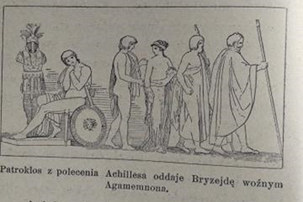
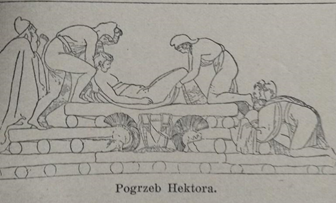
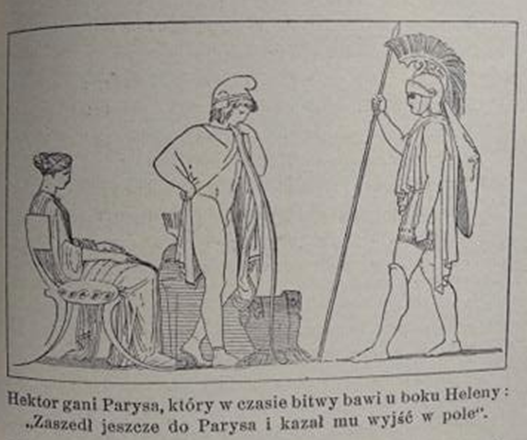
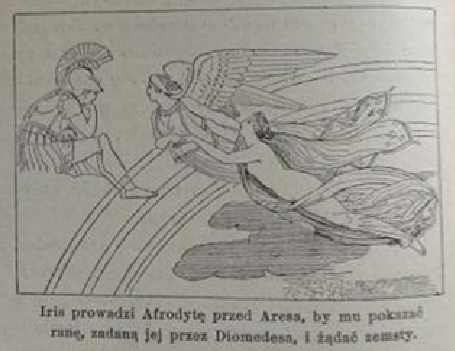
Further Reading
Selected bibliography concerning Jan Parandowski’s work and life see here.
Homer, Iliada, trans. by Kazimiera Jeżewska, intro. by Jerzy Łanowski, Wrocław: Zakład Narodowy im. Ossolińskich, 1986.
Homer, Iliada (wybór), trans. by Franciszek Ksawery Dmochowski, Wrocław: Zakład Narodowy im. Ossolińskich, 1985.
"Jan Parandowski", in: Nowa Encyklopedia Powszechna, vol. 4: M–P, Warszawa: Wydawnictwo Naukowe PWN, 1996, 775.
Addenda
Editio princeps: illustrator unknown, illustrations based on drawings by John Flaxman (see here, accessed: January 21, 2021);
Later editions: ill. Zbigniew Parandowski.
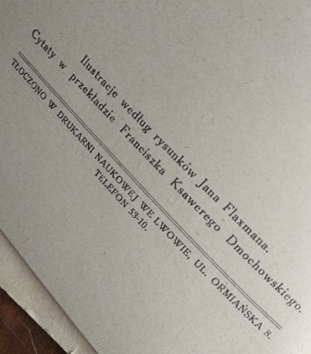
Scan of publishing note: “Illustrations according to drawings by John Flaxman. Quotations in translation by Franciszek Ksawery Dmochowski. Printed in Scientific Printing House in Lwów/Leopolis, 8 Ormiańska street”. Scan by the author of the analysis.


